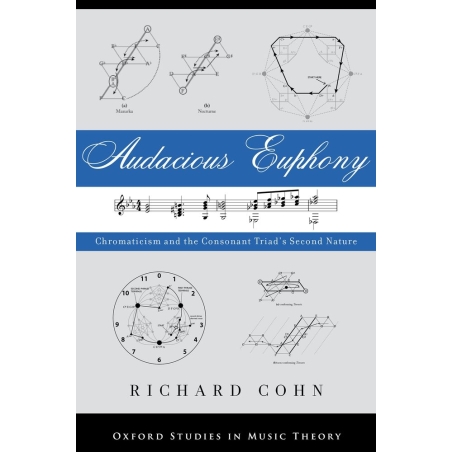Reconstructing historical conceptions of harmonic distance, Audacious Euphony advances a geometric model appropriate to understanding triadic progressions characteristic of 19th-century music. Rick Cohn uncovers the source of the indeterminacy and uncanniness of romantic music, as he focuses on the slippage between chromatic and diatonic progressions and the systematic principles under which each operate.
CONTENTS
Table of Contents
1. Mapping the Triadic Universe
Three Methods for Calculating Triadic Distance
Triads in Chromatic Space
Remarks on Syntax and Maps
2. Hexatonic Cycles: A First Preliminary Model of Triadic Space
A Minimal-Work Model of the Triadic Universe
The Hexatonic Trance
Contrary Motion and Balance
Hexatonic Progressions, Tonnetz Representations, and Voice-Leading
Transformations
Near Evenness, Minimal Voice Leading, and the Central
Role of the Augmented Triad
Remarks on Dualism
Triadic Structure Generates Pan-Triadic Syntax
Triads are Homophonous Diamorphs
3. Reciprocity
The Historical Emergence of Augmented Triads
Consonance/Dissonance Reciprocity
Two Early-Century Examples: Beethoven and Schubert
Three Late-Century Examples: Liszt, Rimsky-Korsakov, Faure
Reciprocity in Weitzmann's Der Ubermassige Dreiklang
4. Weitzmann Regions: A Second Preliminary Model of Triadic Space
The Structure of a Weitzmann Region
Weitzmann Transformations and N/R Cycles
Remarks on the Tonnetz
Historical Origins of Weitzmann Regions
The Double-Agent Complex
Expanded N/R Chains
Weitzmann Regions without Sequences: Wagner and Strauss
5. A Unified Model of Pan-Triadic Space
How Hexatonic and Weitzmann Regions Interact
Chromatic Sequences
Transformational Substitutions
Voice Leading Zones
Remarks on Disjunction and Entropy
6. Navigating the Triadic Universe: Three Scripts
Neighborhoods and Pitch-Retention Loops
Departure T Return Scripts
Continuous Upshifts
7. Integrating Dissonant Harmonies into the Model
Four Eighteenth-century Approaches to Dissonance
Reduction to a Triadic Subset
Hexatonic Poles in Parsifal
The Tristan Genus as Nearly-Even Tetrachord
Circumnavigating the Tristan-Genus Universe
Scriabin's Mystic Species and Generalized Weitzmann Regions
8. Syntactic Interaction and the Convertible Tonnetz
Some Previous Proposals
The Diatonic Tonnetz
Horizontal Extensions
Vertical Extensions
The Convertible Tonnetz
Two Analytical Vignettes: Wagner and Brahms
9. Double Syntax and the Soft Revolution
A Summary Example from Schubert
Double Syntax and its Skeptics
Code Switching and Double Determination
Cognitive Opacity
The Soft Revolution
On Musical Overdetermination
| Series | Oxford Studies in Music Theory |
|---|


